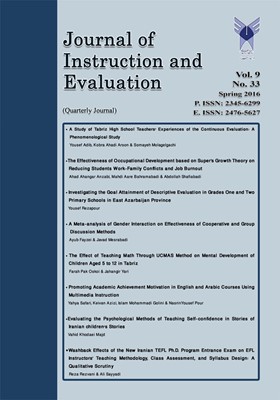The Effect of Teaching Math through UCMAS Method on Mental Development of Children Aged 5 to 12 in Tabriz
Subject Areas : Educational PsychologyFarah Pak Oskouei 1 , Jahangir Yari 2
1 - گروه روانشناسی، واحد تبریز، دانشگاه آزاد اسلامی، تبریز، ایران
2 - گروه علوم تربیتی، واحد تبریز، دانشگاه آزاد اسلامی، تبریز، ایران
Keywords: problem solving, mathematics, UCMAS, numerical memory, logical -mathematical intelligence,
Abstract :
The present study sought to investigate the effect of teaching math through UCMAS method on mental development of children aged 5 to 12 in Tabriz. The design of the study was pretest posttest with control group. The research population included all primary students at the age of 5 to 12 in Tabriz in the academic year 2013-2014 from which , 60 students (30 in the experimental group and 30 in the control group) were selected through cluster sampling. Then, both groups took the pre-test. The experimental group was taught math through UCMASA method. To collect the data, Gobaribonab et al's mathematical problem solving test, Wechsler's numerical Memory Scale, and Abedi's logical mathematical intelligence scale were used. The reliability of the problem solving, numerical memory, and logical-mathematical tests were 0.92, 0.88, and 0.67 respectively. The validity of the test was at a desired level. The analysis of covariance was used for analyzing the data. The results showed that teaching through UCMAS improves problem solving numerical memory, and logical -mathematical intelligence in children. Therefore, teaching math through UCMAS can enhance mathematical skills and abilities in children
احدی، حسن؛ کاکاوند، علیرضا. (1387). اختلالهاییادگیری. تهران: نشر ارسباران.
آناستازی، آن. (1387). روانآزمایی. ترجمه محمدتقی براهنی. تهران: انتشارات دانشگاه تهران.
پاشاشریفی، حسن. (1390). اصول روانسنجی و روانآزمایی. تهران: انتشارات رشد.
تیموری، زینب. (1389). بررسی تأثیر نرمافزارهای آموزشی بر یادگیری مفاهیم پیش از عدد ریاضی در کودکان پیش از دبستان شهر تبریز. علوم تربیتی، 3(1): 65-78.
دبیری، عاطفه. (1385). تأثیر اسباب بازی های آموزشی بر یادگیری برخی از مفاهیم ریاضی برای دانشآموزان دختر عقب مانده ذهنی آموزش پذیر در دوره پیش از دبستان مناطق 6-11 شهر تهران. پایاننامه کارشناسیارشد، دانشگاه علامه طباطبایی.
سایت یوسیمس (1394). http://www.ucmas.ir/
سایت یوسیمس. (2013). http://www.smartakademi.se/research.html
صبحیقراملکی، ناصر؛ ابوالقاسمی، عباس و دهقان، حمیدرضا. (1393). مقایسه تسلط نیمکرههای مغزی A،B، C و D دانشآموزان عادی و ناتوان یادگیری. مجله ناتوانیهای یادگیری، 3(4): 59-79.
عابدی، احمد (1387). ساخت و هنجاریابی مقیاس سنجش و برآورد هوشهای چندگانه کودکان 6 10- ساله شهر اصفهان. اصفهان: سازمان آموزش و پرورش استان اصفهان.
عابدی، احمد؛ کجباف، محمدباقر؛ لعلی، محسن؛ رضایی، مریم؛ حیرت، عاطفه. (1390). مقایسه نیمرخ هوشهای چندگانه دانش آموزان در دو گروه با ناتوانی یادگیری و بدون ناتوانی یادگیری ریاضی. فصلنامه تعلیم و تربیت، 27(2): 67-80.
عارف نیا، سمانه؛ سرندی، پرویز و یوسفی، رحیم. (1391). مقایسهی طرح واره های ناسازگار اولیه در دانشآموزان دوره ی راهنمایی دارای اضطراب مدرسه و دانش آموزان عادی. فصلنامه روانشناسی، 4(1): 74-89.
غباری بناب، باقر نصرتی، فاطمه؛ غلامحسینزاده، حسن. (1393). تأثیر روش خودآموزی بر عملکرد حل مسئلهی ریاضی دانشآموزان اختلال ریاضی. مجله ناتواناییهای یادگیری، 3(3): 55-67.
کلاهدوزی، احمد. (1393). آموزش عالی پژوهش محور؛ مبانی و الگو. تهران: انتشارات گب پاییز.
معتمدی، عبداله؛ برقی ایرانی، زیبا و کریمی، بهروز. (1391). مقایسهی اثربخشی سه شیوهی آموزش مستقیم، آموزش به کمک کامپیوتر و ترکیبی بر کاهش مشکلات دانشآموزان دارای اختلال ریاضی. مجله ناتوانیهای یادگیری، 2(2): 76-100.
نیرو، محمد؛ حاجی حسیننژاد، غلامرضا و حقانی، محمود. (1390). تأثیر آموزش مبتنی بر نظریه هوش های چندگانه گاردنر بر پیشرفت تحصیلی ریاضی دانش آموزان اول دبیرستان. فصلنامه رهبری و مدیریت آموزشی، 5(2): 153-168.
Chen, F., Hu, Z., Zhao, X., Wang, R., Yang, Z., Wang, X., & Tang, X. (2006). Neural correlates of serial abacus mental calculation in children: a functional MRI study. Neuroscience letters, 403 (1-2), 46-51.
Desote, A., Gregoire, T. (2006). Numerical competent in young children and in children with mathematical learning disabilities. Learning and audiovisual differences, 4, 357- 367.
Fletcher, J. M., Lyon, G. R., Fuchs, L. S., & Barnes, M. A. (2007). Learning disabilities: From identification to intervention. New York, NY: Guilford.
Gardner, H. (2004). Frames of mind: The Theory of Multiple intelligenece. Newyork. Basic books.
Geary, D. C. (2010). Mathematical disabilities: Reflections on cognitive, neuropsychological, and genetic components. Learning and Individual Differences, 20(2), 130-133.
Gilmore, C. K., McCarthy, S. E., & Spelke, E. S. (2010). Non-symbolic arithmetic abilities and mathematics achievement in the_rst year of formal schooling. Cognition, 115, 394-406.
Margaret, M., Flores; M., & Kaylor. (2007). The Effects of a Direct Instruction Program on the Fraction Performance of Middle school students At – risk for failure in mathematics. Journal of Instructional Psychology, 84(2), 373-385.
Mark, C. S., Sara, G. T., & Richard, D. W., (2004). Direct instruction and the teaching of early reading. Wisconsin's teacher-led insurgency, 14(3), 1-29.
Milo, B. F., Seegers, G., Wied, A .J. J., Ruijssenaars, M., & Harriet J. (2006). Affective Consequences of Mathematics Instruction for Students With Special Needs, Vermeer Leiden University The Netherlands. [Online]
Ozdogan, E. (2011). Play, mathematic and mathematical play in early childhood education. Journal of Social and Behavioral Sciences, 15, 3118–3120.
Serdar, M. (2007). The effect of multiple intelligences theory (MIT)-based instruction on attitudes towards the course, academic success and permanence of teaching on the topic Respiratory systems. Educational sciences, 7, 231-239
Wu, Y. (2001). Abacus Mental Arithmetic System can promote All-round development of students. Ucmas Chaina.


